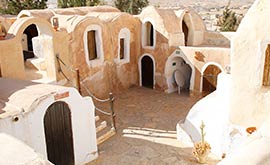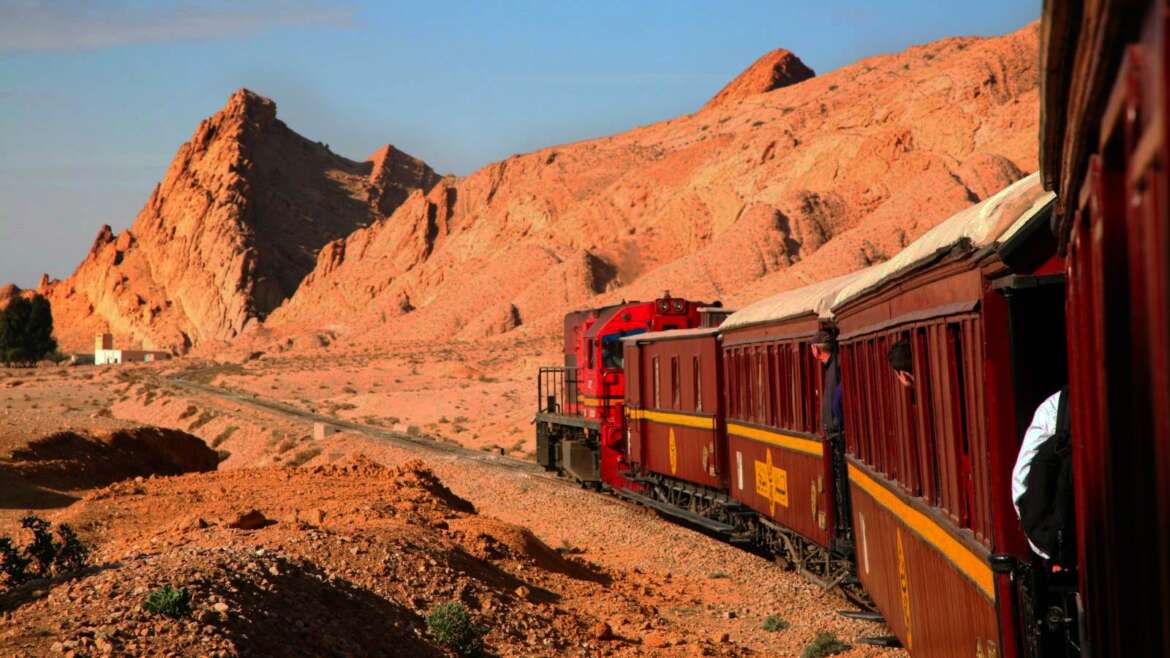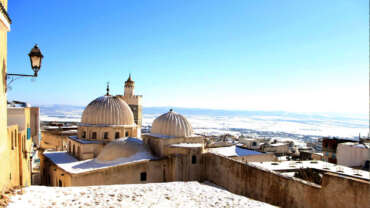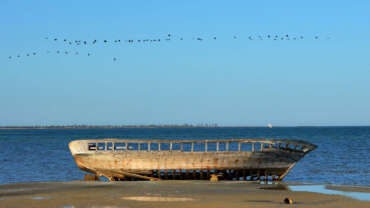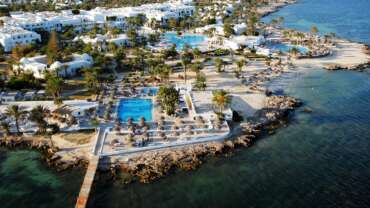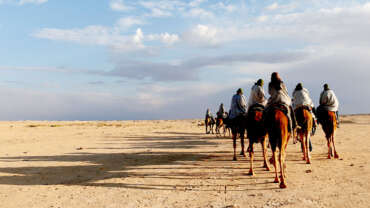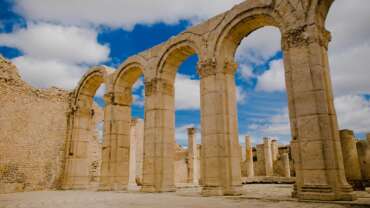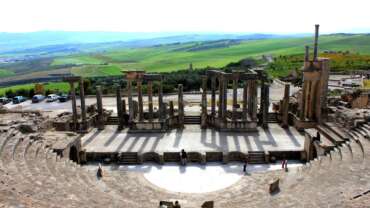Sahara - The magic of light!
The magic of light, bracing air, landscapes that stretch out to infinity and the bare purity of the desert… The call of the Sahara rings out louder as modern life becomes more restrictive and oppressive. The Tunisian Sahara encourages contemplation whether you’re staying in a luxury hotel, a well-equipped campsite or a tent right in the heart of the desert. It comes to life in a 4×4, speeding over rocky roads, or on the back of a camel. It can also offer adrenaline junkies the speed and thrills of extreme sports. Its originality and diversity are as impressive as its facilities. The Tunisian Sahara is the perfect venue for some out-of-the-ordinary experiences.
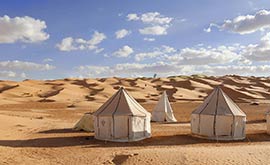
The Grand ERG
The desert just how you imagine it: that feeling of abundance and immensity, the silence, the calm… Tunisia is home to 40,000 square kilometres of sand desert, part of the Grand Erg Oriental, offering absolutely stunning panoramic views of dunes, shaped by the wind. Gently undulating or imposing waves of sand, they turn from yellow to pink at daybreak – a rare spectacle that more than makes up the night spent in a bivouac to catch it. The landscape is constantly changing, and sometimes hides the odd surprise: a well filled with silt, mountains towering over the dunes, basins filled with undergrowth and shrubs, or even a lake inhabited by ducks and egrets. Local guides and camel drivers offer the benefits of their passion and their experience to anyone who would like to discover the emotions of a journey through the Sahara.
Highlights:
• The beauty and variety of the sites.
• Ease of access, proximity of tourist facilities and refuelling stations.
• Fantastic opportunities for walks, camel rides and motorbike, quad bike or 4×4 adventures.
• Some routes are on tarmac and so suitable for passenger cars.
• Routes secured by regularly spaced out military posts and refuelling stations.
Douz and Chott el-Jerid
Covered in a thin white layer like a snow-covered landscape, the Douz region offers the easiest way into the desert. Strings of dunes and graceful clusters of palm trees line the tracks carved out of the sand. The pale white immensity of the desert is there, within your grasp. Douz is inhabited by the Mrazig, nomadic farmers who even now occasionally leave their permanent homes to spend some time in a tent. Not far from Douz, the vast palm groves of Kébili and Deggache are lovely, shaded places to stay in the date palm forests. In contrast, the sandy villages of Sabria, Nouil, El Faouar and their little oases seem lost between the sandy desert and a huge expanse of the shimmering salt lake, Chott El-Jerid.
Highlights:
• The excellent choice of accommodation, hotels with views of the dunes.
• Immediate access to the desert.
• The presence of the nomadic culture, the big weekly market.
• Activities available (ULM flights, quad biking, sand skiing, land sailing and speed sailing on Chott el-Jerid).
• The many Saharan camps.
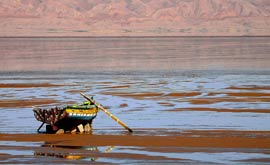
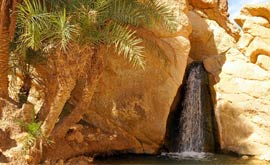
Canyons and Oases
Tozeur rises up out of the desert, nestled into a huge oasis that is home to hundreds and thousands of palm trees. This surprising, fascinating place feels a very long way away from Europe, which is in fact just a few hours away. The dazzling southern light pours into the avenues of the town. It forges a path for itself through the narrow alleyways of the old parts of town and between the tall, pale brick façades. These textured bricks form complicated diamond and chevron patterns on the walls. The small town of Nefta distinguishes itself from its neighbour thanks to its rich Sufi tradition; it is home to countless domes, marking sanctuaries and tombs of saints. It overlooks a palm grove that curls up like a bunch of flowers beyond a basin, called the Corbeille.
A few dozen kilometres from Tozeur and Nefta are Chebika, Tamerza and Midès, oases in a landscape of mountains that is one of the most moving sites in southern Tunisia. In this breathtakingly beautiful landscape every oasis is different. In Chebika, a wadi runs down the side of a steep mountain, forming waterfalls and rivulets where frogs have made their home. The old village of Tamerza, abandoned like a ghost village, looks out at a spectacular mountainous landscape; its lush oasis is fed by a towering waterfall. Last but not least, Midès, tucked away into a dizzyingly high canyon, boasts spectacular views. Further east, you can see another stunning landscape carved by erosion: the huge canyons at Dghoumès.
Highlights:
• The excellent choice of accommodation and luxury hotels.
• The relaxing atmosphere, the brick architecture.
• A ride in a horse-drawn carriage, on a mule or on a bike through the palm grove promenades.
• The sand dunes a few kilometres away from Nefta.
• The set where Star Wars was filmed at Onk Jemel (near Nefta).
• The many attractions in Tozeur and the surrounding area: golf, museums, theme parks, Lézard Rouge train.
• The canyons at Chébika, Tamerza, Mides and Dghoumes.
Ksour and Berber villages
Right in the heart of a dry, mountainous landscape studded with plateaus and craggy peaks, the stunning architecture of Ksour rise up before you. Hidden away in the middle of nowhere, looking like huge rock-coloured beehives, these “desert castles” (“ksour” is the plural of “ksar”) were once meeting points for the region’s semi-nomadic people who stored their harvests there, safe from looters, in overlapping store rooms called “ghorfas”. Some Ksour, like the ones at Chenini and Douiret, are villages nestled on top of impregnable summits. The ruins of their “ghorfas” blend in to the tops of the mountains, and the homes are partly hollowed out of the rock walls. The Berber language is still in use today. Further north, the landscape mellows as it approaches Gabès, the large seaside oasis.
Highlights:
• The originality of the sites and ways of life.
• Berber crafts (weaving).
• The chaotic, spectacular landscape, the lure of adventure.
• The number and variety of Ksour, which are attractions in themselves.
• The option to stay in some Ksour and converted troglodyte houses.
